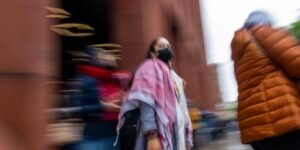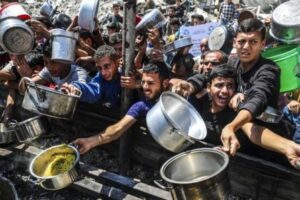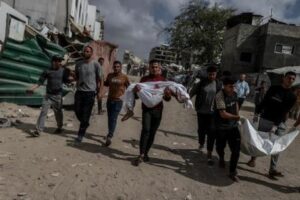Sri Lankan President Gotabaya Rajapaksa has finally been toppled after days of mass protests in the capital, Colombo. Hundreds of thousands of people descended on the city on 9 July, exactly three months after the #GotaGoGama (go home Gotabaya) movement began.
Rallies also took place in towns and villages across the country after fuel shortages prevented many people from getting to Colombo. Some nevertheless found creative ways to travel. For instance, dozens packed into cattle trucks or commandeered heavy machinery from construction sites. Protesters in Kandy, a city in the central highlands, arrived at the train station early only to find that officials had instructed staff to cancel departing services. But they convinced the drivers to take them to Colombo anyway, the trains adorned with giant banners demanding Gotabaya’s resignation.
Videos and pictures posted on social media showed protesters overwhelming police barricades to claim the city streets. Gotabaya’s official residence was the first building to fall. Hundreds of people streamed into the palace and quickly made themselves at home—diving into his pool, drinking his whisky, working out in his gym and cooking in his kitchen, marveling at the luxuries enjoyed by the man who oversaw the collapse of the country’s finances.
Next was the president’s office in central Colombo. One video circulating on Twitter captured the moment the massive crowd broke through the military barricade: the people heaved against one another for about a minute until the sheer weight of the assembled protesters smashed through. The first man to reach the steps of the building froze, seemingly stunned by the victory, before turning back to face the crowd and pumping his fist in the air.
Prime Minister Ranil Wickremesinghe, appointed by Gotabaya after his brother Mahinda was forced to resign in May, was also targeted. After he refused to resign, a crowd broke into his ancestral home, lighting a section of it on fire. There are many incredible images from the day—including the moment a water cannon, firing at a scrum of thousands of people, was captured by protesters who kicked the cops out of the cabin and scrawled “give back our stolen money” on its side.
In the following days, more state buildings—official symbols of elite power—were occupied and turned into public galleries. Protest organizers encouraged families to come and see for themselves the obscene wealth of the country’s rulers.
Gotabaya quickly went into hiding, as did Wickremesinghe, both saying that they would be willing to resign. On 11 July, Gotabaya was spotted at the airport trying to flee the country but was blocked by airport staff. He eventually made it out of the country on a military plane, first to the Maldives, where crowds of Sri Lankan expats immediately began protesting, and then to Singapore on a Saudi plane. (Suffice to say that his exit, while no doubt unedifying, was worlds away from the experiences of tens of thousands of Tamils who have fled the country since the former defense minister initiated the genocide in 2008-09.)
Basil Rajapaksa—Gotabaya’s brother, who had recently been forced to resign as finance minister—was also prevented from leaving at the airport, and has now, along with Mahinda, been barred from leaving the country until 28 July without the Supreme Court’s permission.
The president has now officially resigned. This is an extraordinary achievement of the Aragalaya (struggle in Sinhalese) protest movement. The Rajapaksa family has ruled the country for most of the last twenty years, using state positions to enrich themselves. This goes some way to explaining why Gotabaya resigned only after leaving the Island—he probably feared prosecution for corruption.
The Rajapaksa’s are gone, at least for now, but Ranil Wickremesinghe remains. Leader of the United National Party, Wickremesinghe has held the prime ministership five times since 1994 and is now despised by the population for propping up the Rajapaksas over the last two months. He ordered the military to “do whatever is necessary to restore order” after protesters occupied his office, calling the movement a “fascist threat to democracy”.
Wickremesinghe is the front-runner to gain the presidency—due to be decided by the parliament on 20 July—although protest leaders have vowed that the movement will not accept him. The other options are no better. Candidates include current leader of the opposition and Wickremesinghe protégé Sajith Premadasa, war criminal Sarath Fonseka and staunch Rajapaksa ally DullasAlahapperuma. All have been part of Sri Lanka’s ruling elite for many years.
How exactly the Aragalaya movement will respond to a new president is unclear. Until now, there has been unity around the key demand for Gotabaya to resign. The movement has been a broad front of trade unions, student unions, youth wings of opposition parties, and church and community leaders. But political divisions among protest leaders and the different organizations could now emerge—the Sri Lankan news site Daily Mirror has reported on clashes between different groups at protests in the last week.
It’s also unclear how the military will respond if protests re-emerge in the coming weeks or months. The army is held in high regard among the Sinhalese population, and its power was expanded during the Rajapaksa’s rule. Sri Lanka is by no means a military state, but the armed forces’ presence in daily life is greater than in other democracies.
During a day of violent clashes on 13 July, Chief of Defense Staff Shavendra Silva fronted a press conference alongside the heads of the air force, army, navy and police, instructing political leaders to find a solution to the crisis and imploring the Sri Lankan people to follow the directives of soldiers on the ground. Dangers now include a more direct political intervention by the military or intensified repression of renewed protests.
The movement has been criticized by leftists within Sri Lanka and abroad for not breaking with the dominant ideology of Sinhala-Buddhist nationalism, which is close to a state religion and the basis for the decades-long oppression of the Tamil population. It is certainly a weakness of the movement that it has not broken with the ruling ideas of the Sri Lankan elite. If a left-wing political current is to be built out of this struggle it will have to be based on a solidarity between all the oppressed on the Island—from the Sinhalese working class to the Tamil and Muslim minorities.
But the lack of a clear break from the country’s ruling, and founding, ideology is not a good reason to reject the struggle out of hand. Movements like this can challenge the old ideas as people once divided fight together against a common enemy—in this case the Sinhalese elites who waged war against Tamils, encouraged pogroms against Muslims and who now destroy the living standards of working-class and even middle-class Sinhalese.
There needs to be a fight for these ideas within the movement, but ultimately, people need to be confronted by the demands of the oppressed, raised as part of a joint struggle. In that sense, the “Tamil question” has not yet been posed in any real sense. While Tamils living in Colombo have taken part in the protests, and there have been isolated examples of individuals trying to draw attention to the oppression of Tamils, there has been no organized Tamil bloc, and the main Tamil regions in the north and east have not decisively entered the struggle.
That’s not to downplay the actions of those individuals raising Tamil demands. They are heroic under the circumstances. But while they may challenge or even convince individual Sinhalese, they simply can’t pose the question for the movement as a whole. Individuals, and even small groups, can’t create a situation in which the movement must address the Tamil question to go forward or to avoid splitting and falling into disarray.
It nevertheless remains important to keep raising the issue. Ethnic divisions run deep in the structures of the Sri Lankan state—if this movement or a future movement manages to seriously challenge them, it will transform politics on the island, be an immense step towards the creation of a new left and open a new chapter in the fight not only against ethnic oppression but in the fight for genuine working-class unity.
The protests have subsided since Gotabaya’s resignation, and protest leaders have ended the occupations of state buildings after a night of mobilizations on 13 July, which left dozens in hospital.
Much is still unknown about how this struggle will develop. But one thing is for certain: the crisis of Sri Lankan capitalism is far from over. The government has run out of money, food and fuel remain scarce, and economists predict that the situation will get worse before it starts to get any better.
The most immediate problem for the government is access to finance. The new president will be unable to provide people any relief if the government cannot quickly secure international loans. This will be a key source of ongoing instability—most people have been rationed down to two basic meals a day cooked over an outdoor wood fire. This scarcity is what sparked the movement against the Rajapaksas in the first place.
Politicians are pursuing a deal with the International Monetary Fund. This might result in quick access to finance that the state can use to ship in fuel and other essential items—but anything from the IMF will come with strings attached. The working class will somehow be made to pay for the “generosity” of the international bankers.
Moreover, Sri Lanka is facing a dire economic outlook for which there is no quick fix. Global interest rates are climbing, and the local currency value is falling against the US dollar—a double whammy for an indebted country. Add to this the ongoing inflationary crisis and there is no-doubt a basis for mass protests for a long time to come. No amount of personnel changes at the top are going to change those equations.
Courtesy Red Flag



